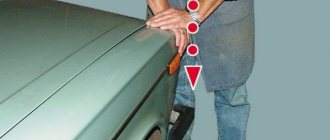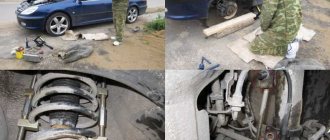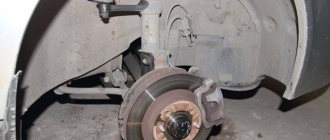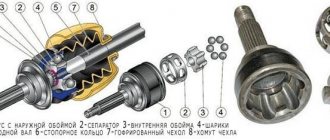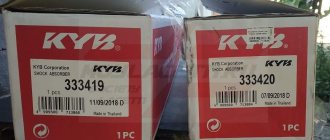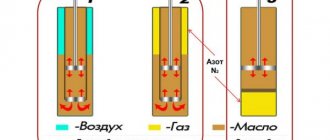The information in this article will be as useful and informative as possible for car enthusiasts who are just beginning to study the design features of a car. The question of what front shock absorber struts are, what is the importance of these elements, and how to replace them when they wear out or break down will be covered in detail.
The device of the front shock absorber struts
Many drivers mistakenly draw a parallel between concepts such as a shock absorber strut and the shock absorber itself. Some of them believe that this is an ordinary spring, or call all the elements of this system assembled together a strut. To understand that this is an erroneous opinion, it is worth studying in more detail the question of what racks are and what features of their design are present.
A shock absorber strut is a component that is required to connect components such as the body and wheels of a vehicle. This support is connected to a spring and a damper, which, by the way, is the main component of the shock absorber.
This design contains the following elements:
- Cylinders containing a piston and special hydraulic fluid.
- Hydraulic fluid, which can be presented in the form of a mixture of liquid and gas, as well as a certain mixture of gases. The composition is necessary to transfer forces between two types of shock absorbers.
- Stock. Designed to hold the piston on itself and is required to transmit serious pushing forces.
- A piston with a special bypass valve. It moves in the inside of the cylinder. Used for smooth transmission of vibrations.
- Seals, seal and high-quality sealant.
- An enclosure designed to house the various components of a rack inside.
- Fasteners necessary to connect the main parts of the shock absorber to the car body.
If you study the design of the elements, you can understand that the front shock absorber struts (AS) may or may not be equipped with springs. The choice of one or another option must be made based on the design features of the suspension and an acceptable budget.
Like all car parts, front shock absorber struts wear out over time, break and become completely unusable. If this phenomenon is detected, the front strut shock absorber should be replaced as soon as possible.
Operating principle and design
The vertical forces arising in the suspension are transmitted through the rod to the piston, which moves longitudinally in a cylinder filled with a working medium. The piston acts on the working medium and forces it to decrease in volume. After the load is removed, the elastic elements of the suspension return to their previous position, dragging the rod with the piston along with them, and the working medium takes on its previous volume.
The shock absorber body is covered with a cylindrical casing attached to the rod and serves to protect it from dirt and mechanical damage.
In the chassis of the car, the shock absorber is connected by a rod to the frame (body) of the car, the lower part is fixed to the suspension arm or to the bridge. Rubber-metal hinges are installed at the attachment points.
Acting as a damper, the shock absorber simultaneously serves as a suspension travel limiter, so a rebound buffer is installed on the rod.
According to the type of working fluid (medium), all structures can be divided into:
- Hydraulic (oil);
- Gas (gas-filled);
- Gas-hydraulic (gas-oil).
Hydraulic (oil)
Under compressive loads on the rod, oil flows from the cavity under the piston into the rod cavity through calibrated holes equipped with forward and reverse bypass valves. Valves slow down the rate of change in fluid volume and, accordingly, the speed of the piston.
A significant part of the compressive and tensile loads is spent on pumping oil; the speed of movement of the piston is limited by the viscosity of the working medium.
Gas (gas-filled)
They differ from oil ones in that after the piston cavity filled with oil, in the working cylinder there is a chamber with compressed gas (nitrogen), separated from the oil by a floating piston. Nitrogen pressure reaches 30 MPa.
The longitudinal forces acting on the rod are transmitted by oil to a floating piston, which changes the volume of the gas chamber.
Gas-hydraulic (gas-oil)
The oil-free volume is filled with nitrogen under pressure from 2 to 8 MPa. During the compression stroke, the piston forces oil out through the valves, compressing the nitrogen. During the rebound process, the oil is returned to the piston cavity by nitrogen pressure.
According to the internal structure they distinguish
- Two-pipe.
- Single-pipe.
Double pipe
The body consists of two coaxial cylinders - an internal working one, in which the rod and piston are located, and an external one, called a reservoir.
The oil displaced during compression is pumped into the rod cavity of the working cylinder and at the same time forced into the reservoir cylinder.
All oil and gas-oil shock absorbers are of a twin-tube design.
Monotube
All monotube shock absorbers are gas-filled. In a common body, which is also a working cylinder, there is a rod with a piston, oil and gas chambers, separated by a floating piston.
The most popular type of shock absorber today.
The principle of operation of the front struts
To understand how the front shock absorber struts of a vehicle function, the MX should be divided into two main structural elements - a spring and a shock absorber. They are the ones who put the whole mechanism into action.
Spring
The main element of this part is designed to level out a variety of defects in modern road surfaces. It is also necessary to reduce vibration activity, which is reflected on the body during movement. When moving along a heavily broken road, it is thanks to the spring that the driver only feels the smooth rocking of the car. the spring absorbs the most powerful shocks, that is, completely dampens them.
The metal from which the spring is made must have optimal elasticity. Typically, the steel used is one that is optimally suited for a specific vehicle brand, its weight and general specialization.
The spring is installed with one side in a special cup of the rack, and the other part passes through a rubber spacer, which, in turn, rests against the body.
Shock absorber
This is the stand itself, which, when compared with the same spring, is a more complex part in its design. Here are the most basic design features:
- A two-chamber cylinder along which a piston moves, pre-attached to a rod. It is this that is filled with gas or liquid.
- The working composition circulates in the inside of both chambers, on the basis of which all struts, like standard shock absorbers, are divided into several types.
The main task of a shock absorber is to dampen vibrations that come from the spring. The depreciation procedure implies a serious increase in the level of pressure generated by the internal part of the part. Its reduction is carried out due to special valves, which are located directly on the piston. Depending on the general position, the elements automatically close and open so as to effectively regulate the applied loads.
This is interesting: What to do if the Chevrolet Cruze does not start, how to fix it
Application
In the automotive industry
The approach to the purpose of a shock absorber in various schools of automotive engineering can to some extent be determined by the name that is given to it. For example, German Dämpfer - vibration damper (damper), English. Shock-absorber - shock absorber.
In tank building
In tank building, the operating principle of German telescopic shock absorbers from the Second World War (Pz.III, Pz.V, Pz.VI tanks) and the friction shock absorber of the modern Leopard-2 does not provide for shock absorption. The first ones are single-acting during the reverse stroke of the roller, that is, if there is an impact during the forward stroke of the roller, they practically do not work; the resistance of the second does not depend on the speed of movement of the roller, therefore, upon impact, the shock absorber will absorb approximately the same amount of energy as when the roller moves slowly by the same amount . The British mainly used double-acting hydraulic shock absorbers (Crusider, Cromwell, Valentine tanks), the resistance of which depends on the speed of movement of the roller and increases many times upon impact, hence the name “shock absorber”.
In aircraft engineering
In aircraft engineering, powerful shock absorbers are used on aircraft landing gear. Their task (as well as the task of the entire chassis structure) is similar to shock absorbers in cars - to soften overloads upon contact with the runway surface during landing, so that the loads on the aircraft components do not exceed permissible values during a normal landing, and also so that in emergency cases make a safe landing for people when exceeding the maximum landing weight up to the maximum take-off weight.
Shock absorbers on the landing gear of almost all modern aircraft are built on the principle of a gas spring - the elastic element in such a shock absorber is not a mechanical spring, but technical nitrogen, charged (pumped into the shock absorber cavity) from a ground-based airfield nitrogen tanker, under a strictly defined pressure, depending on the take-off weight of the aircraft for a given flight and ambient temperature. Single-chamber, two- and even three-chamber shock absorbers are used.
By rail
In railway transport, energy must be dissipated in both the vertical, horizontal transverse, and horizontal longitudinal directions relative to the movement. Shock absorbers in the first two directions are usually oil-based and are installed at an angle of 45 degrees between the vertical and horizontal planes transverse to the movement. That is, one shock absorber absorbs energy in two directions. Longitudinal shock absorbers of railway rolling stock are called the draft gear of an automatic coupler. Draft gears are divided into cargo and passenger types. Load-type draft gears are distinguished by classes T0, T1, T2, T3 - depending on the energy it absorbs (50 kJ - the first and 190 kJ - the last) and its other technical characteristics described in OST-32-175-2001.
In shipbuilding
In shipbuilding, rubber-metal shock absorbers AKSS (welded ship shock absorbers with insurance) are used to protect equipment from vibration and shock loads. The AKSS shock absorber is a rubber-metal product consisting of a metal bracket, a carrier bar and a support bar, which are interconnected by a vulcanized rubber mass. To protect electrical panels and control panels from vibration and shock loads, cable shock absorbers are used in shipbuilding.
Purpose of the front pillars
Any type of elastic metal from which the spring is made, when exposed to one or another mechanical factor, forms automatic residual vibrations, which cause serious discomfort to passengers and the driver. It is to dampen such shaking and vibrations that the shock absorber was developed and is widely used. It can completely transform sharp shocks into almost imperceptible soft vibrations.
Shock absorber struts play a major role in the structure of the entire vehicle suspension. Due to the relatively small size and ease of maintenance, the manufacturer produces structures at minimal cost.
Due to their small dimensions, the racks take up minimal free space. Due to this, you can easily place additional levers and other structural elements that can make the trip as comfortable as possible.
At the same time as increasing the level of comfort, the front shock absorber strut is designed to perform the following functions:
- maintaining vehicle weight;
- transfer of adhesion force with asphalt pavement to the body;
- maintaining the optimal position of the body in relation to the car wheels;
- eliminating excess roll;
- taking on serious lateral loads.
The price of the struts is an order of magnitude higher compared to the shock absorbers themselves. The reason is a more complex design, as well as the fact that high quality materials are used in production.
Types of front struts
All car struts operate using a special working fluid. Based on the substance used in the cylinder device, front shock absorber struts can be divided into three main types:
- Oil or hydraulic. They are effective when traveling within the city, as well as on country roads.
- Gas. They are distinguished by higher rigidity rates. This is the best option for modern sports cars. It is believed that gas structures belong to the category of more modern devices. But if the car often moves on dirt roads, this category of shock absorbers is not very suitable.
- Gas-oil. As numerous reviews say, this is the optimal solution for any vehicle. All the positive characteristics of the categories of shock absorbers listed above are present here.
The front and rear pillars are different from each other, so you need to be careful during the purchasing process.
The front ones are slightly higher in length and have a smaller diameter. There are no steering knuckles in the rear shock absorber designs. Additionally, rear struts are much more difficult to replace than front struts.
Shock absorbers in a car suspension: how are they designed and how to change them?
Everyone knows that a shock absorber softens impacts when driving over uneven surfaces. In fact, its role in a car suspension is somewhat more specific - it is a damper, it prevents the car from swaying when hitting obstacles. Today we will study its typical design, and at the same time we will change the front pair of shock absorbers to Chevrolet Lanos. Now you will know why they charge relatively a lot of money for such a seemingly simple manipulation.
What is a shock absorber used for?
To begin with, let’s “separate the flies from the cutlets,” that is, let’s understand the roles of the different suspension elements. On most modern passenger cars, the main elastic elements are springs. 30–40 years ago, this role was mainly performed by springs, working “part-time” and as dampers. The vibrations were successfully damped due to friction between the spring leaves. We won’t go into detail about the shortcomings of springs and their typical problems; we’ll devote separate material to them, but now let’s just remember their existence and return to springs.
They are installed between the suspension and the car body and are designed to absorb shocks to the body coming from the road. When the wheel rolls onto some obstacle, the spring is compressed, and the body moves only slightly and smoothly upward, the wheel rolls off the obstacle - the spring straightens.
There is, however, one unpleasant moment. Let’s take, for example, a bouncy toy – a rubber ball, which can also be classified as an elastic element. Hit him on the ground and time him until he stops jumping completely. Your car will jump approximately the same way if its suspension design contains only levers and springs. And, depending on the stiffness of the springs, the suspension will be either stone or soft, like cotton wool, but in either case you don’t even have to think about the car’s handling. The worst thing for such a suspension is resonance, when vibrations enter it they can destroy individual elements of the suspension and its fasteners.
The problem was solved by introducing a shock absorber into the suspension design - an element that allowed the wheel to move relative to the body, but prevented the car from rocking. Initially, these were lever-type shock absorbers, which, like springs, performed their function due to friction. But we will not dwell on anachronisms; we will consider only modern designs. At the moment, the “mainstream” for passenger cars is telescopic hydraulic shock absorbers. This time we will not take pneumatic and hydropneumatic systems, as well as shock absorbers of variable stiffness - these are topics for separate articles.
Operation of the telescopic shock absorber
To simplify it as much as possible, the operation of a shock absorber can be described as follows: there is a cylinder filled with oil, a rod with a piston moves inside the cylinder. This piston has valves that open in one direction only.
When the piston moves down, some valves open and liquid flows into the cavity above the piston; if the piston moves up, other valves open and liquid flows into the cavity under the piston. Damping of vibrations occurs due to the fact that the oil does not compress and has a certain viscosity.
By the way, why are valves needed at all? Maybe holes would be enough? Actually, not enough. One of the important characteristics of a shock absorber is its rebound and compression stiffness. In other words, it is the resistance on the shock absorber rod as it is pushed or pulled out of the body. Valves are needed to regulate this rigidity.
Due to the different flow characteristics of the valves, it is a little easier to press the shock absorber rod in than to pull it out of the shock absorber. This was done with the expectation that when hitting an obstacle, it is necessary not to interfere with the wheel moving upward in order to prevent the transfer of shock from the wheel to the body. In this case, the valves allow more oil to pass through. But if there is a big hole on the way, then the wheel should be kept in a “tucked” state, why rush to fall into it? Therefore, the damper valves allow less oil to pass through.
Once again: valves are needed to set a certain stiffness of the shock absorber in different directions of its operation.
Types of structures
Structurally, shock absorbers can be divided into three main types: two-pipe, two-pipe with gas pressure and single-pipe with gas pressure. Twin-pipe hydraulic shock absorbers were the first to appear on cars. In them, as the name suggests, there are two pipes - cavities, in one of them (inner) there is a piston with the above-mentioned valves, the other (outer) is necessary to compensate for the volume of oil - it is only partially filled with oil, the rest is air.
During operation of the shock absorber, the oil inside heats up to high temperatures, this causes it to expand, and so as not to squeeze out the rod seals, the liquid flows into the outer cavity.
This type of shock absorbers has few advantages: they are cheap and have little impact on their operation from dents on the body. It is also worth mentioning the good smoothness of the car and the relatively low rigidity of such shock absorbers.
The disadvantages include overheating of the working fluid, since the body is double, and cooling with atmospheric air is difficult. Due to overheating, there is a high probability of oil foaming and, as a result, an immediate loss of operating efficiency - the shock absorber ceases to perform its function, and the car becomes poorly controlled due to rocking.
The next disadvantage is the large weight of the twin-pipe shock absorber, as well as a strictly defined installation location - if it is turned over, the working fluid will leak out. The weight of the shock absorber affects the amount of unsprung mass (we’ll talk about what this is separately). The greater the unsprung weight, the worse the ride and handling of the vehicle.
A small improvement in twin-pipe shock absorbers was the filling of the outer cavity with gas with a slight excess pressure. In this way, the likelihood of foaming was reduced, since the oil in this case “rests” on the gas cushion.
Hydraulic monotube gas-filled shock absorbers are a completely different matter. One cylinder filled with oil, a piston with one-way valves and a small cavity filled with gas and covered by the piston.
A mono-tube shock absorber does not have all the disadvantages of a double-tube shock absorber. During intensive work, the liquid does not overheat, since it is separated from the environment by only one cylinder wall and is perfectly cooled. It is also lighter and can be installed either up or down.
But the laws of nature cannot be avoided: you win somewhere, you lose somewhere. Therefore, the advantages of double-tube shock absorbers have become the disadvantages of single-tube shock absorbers. The latter are much more expensive and very sensitive to mechanical damage to the body, therefore, operating a car with them, although not so much, is more expensive.
Installation of shock absorbers
The installation methods for shock absorbers have not changed since their introduction into cars. So, their upper part is always attached to the car body or frame, and the lower part is always attached to a suspension element, be it a lever or a continuous axle beam. Because of this, replacing this element in the vast majority of cases did not cause difficulties: I unscrewed the lower fastening bolt, unscrewed the upper fastening bolt, and that’s it, the shock absorber was in my hands.
With the shock absorbers of the rear suspensions everything remains the same, but with the front ones everything is a little more complicated. With the advent of front-wheel drive cars, the question arose of where to put the shock absorber, which was mainly attached to the lower arm of the front suspension and interfered with the installation of the drive shaft.
There were two main solutions to this problem. The first option is to install the lower part of the shock absorber on the lever through a U-shaped bracket, inside which the drive shaft passed. The second option is to move the shock absorber along with the spring to the space above the upper suspension arm. In this case, the lower part of the shock absorber is attached to the upper suspension arm, and this entire structure is named after the American engineer Earl Steely McPherson.
McPherson developed this fundamentally new type of suspension for the ultra-budget Chevrolet Cadet concept car in the 1930s. In practice, it was only possible to use it after the war, already on the 1948 Ford Vedette for the French market. Now that you know this short, exciting story and can show off your erudition on occasion, let’s move on to the features of this still popular design.
McPherson combined the shock absorber and spring into one shock strut. In this rack, the upper part has a hinge with a bearing and rests on a body element - the glass. Thanks to the support bearing, the stand can rotate around its own axis. And if you install the shock absorber strut at a certain angle, then you can set the trajectory of the wheel and the angles of its installation, such as camber, the angle of longitudinal and transverse inclination of the steering axis (we will definitely consider what this is in future publications).
It turned out that with this installation of the strut, you can get rid of the guide of the upper suspension arm, thereby reducing the cost of it. The steering knuckle in the suspension is attached to the ball joint of the lower arm and to the shock absorber strut, and rotates with it. The anti-roll bar in this case can be attached either to the lower arm or directly to the shock absorber strut.
If we consider the methods of attaching the strut to the steering knuckle, there are several of them. The steering knuckle can be attached to a bracket on the strut body. Often - two eccentric bolts with nuts, and they are also elements for adjusting the camber of the wheels. If the wheel camber is designed structurally, then adjustment is not needed, which means that the strut can be secured in the steering knuckle bracket. The mounting bracket in this version is an eyelet with a cut, which is tightened with one bolt. The simplest option is to press the strut housing into the steering knuckle (like our experimental Chevrolet Lanos). All this is often supplied as one part - assembled with a fist.
The list of disadvantages of the MacPherson strut includes relatively small suspension travel and, as a result, such a design is very rare, if not an exception, on real SUVs (however, there are almost no such cars left). And the reason is that with maximum compression of the strut spring, the wheel alignment angles begin to change very strongly, which entails a serious deterioration in the car’s handling and leads to excessive tire wear.
Shock absorber struts can be with or without the ability to replace the shock absorber. In the first version, the strut housing with the spring support is made separately from the shock absorber. In the second, the shock absorber body is simultaneously the strut body, and the lower spring support is mounted directly on it. The upper spring support is attached to the shock absorber rod. The spring at the top and bottom acts on the supports through rubber pads. An elastic bumper is installed on the shock absorber rod - a rubber or polyurethane bushing that prevents shock from the suspension parts when the spring is fully compressed.
The spring in the shock absorber strut is always under tension. Initially, compression is necessary to eliminate backlash and gaps in the assembly. Replacing a strut on a car is always a little joy for a mechanic, since the cost of the work is quite expensive.
Example of replacing shock absorbers
So, let's move on to the repair area, where the Chevrolet Lanos with its front collapsible shock absorber struts awaits us. We leave the old springs, but change the shock absorbers. The owner of the car decided that the standard twin-tube front suspension shock absorbers were too soft and it lacked handling. The solution was to install front monotube gas-filled shock absorbers.
Let's get started. Unscrew the nut securing the drive shaft to the wheel hub, then unscrew the mounting bolts and remove the front wheel. Next, to make it easier to unscrew the fastening elements, we spray the life-saving WD40 on the joints of the ball joint of the lever and the joint of the steering rod end.
Source
Life time
The total operating time of front shock absorbers, as well as the frequency of their replacement, directly depends on three main factors:
- part quality;
- level of compliance with vehicle weight;
- manner of traveling by car.
For this reason, on some machines parts have to be changed every 6 months, while on others the designs last for 7 years.
Such a difference in service life is based on improper operation of vehicles, as well as poorly selected main structures and springs. Neglect of these rules can lead to the fact that the load will not be distributed evenly, which will automatically negatively affect the service life of the entire shock-absorbing system of the car.
Signs of problems
If the right or left rack fails, this can lead to an emergency situation. It is for this reason that it is so important to carefully monitor your vehicle. Timely repair work will avoid a large number of problems.
The following signs and characteristic symptoms indicate a breakdown of the front struts:
- during the movement there is a constant creaking, knocking and clicking sound;
- the car constantly rocks and oscillates from side to side;
- the car skids seriously when turning;
- To perform braking, a much longer braking distance is required than with working shock absorbers;
- the vehicle squats heavily as soon as the driver accelerates or brakes. Unpleasant sensations are present both behind and in front;
- the machine clings to the surface very poorly;
- rubber wears out very quickly and unevenly;
- Brake fluid leaks from the shock-absorbing system;
- the supports, spring and rod become covered with destructive corrosion;
- a significant increase in noise level during acceleration. This indicates that the fasteners of the built-in bushings have been damaged;
- the housing is deformed, which is why the piston cannot move normally in the inside of the cylinder;
- The springs are not positioned very correctly, as a result of which the car body begins to sway while driving.
This is interesting: How to remove and check a faulty fuel pressure regulator (FPR)? 6 simple steps
Such phenomena usually occur due to the poor quality of the main elements of the racks, due to improper installation, as well as due to the natural process of wear and aging of the built-in elements.
It is impossible to say which racks you need to buy. It all depends on material wealth and the vehicle itself. In any case, there is no need to save on these elements. It is worth buying designs that have a large number of positive reviews and are produced by trusted manufacturers.
Front strut replacement process
If the bearing, upper support and the entire strut as a complete assembly have already served their useful life, there is only one way out - replacing the front shock absorbers. This operation on the front of the car can be done with your own hands.
If the left or right strut is worn out, both will need to be replaced at the same time.
When making a replacement, you must rely on a special repair manual. Despite the fact that there are certain differences in the design of different car brands, the algorithm of action is similar in all cases. The sequence of manipulations here is as follows:
- Access to the upper support of the rack is freed. Here you will have to remove the engine compartment seal.
- The plug is removed and the fastening nut of the AC rod is unscrewed. You will need a head, as well as an extension with a knob. It is advisable to carry out this operation when the rack itself has not yet been dismantled.
- It is worth loosening the wheel fasteners, and then jacking up the car to such a position that the tires do not touch the ground. Here you definitely need to ensure that the jack does not fall off.
- The wheel is being removed. Using a metal brush, you need to clean all the structural elements located there. It is advisable to treat them with WD40 and wait for the composition to take effect.
- The fastening nut is unscrewed from the installed stabilizer joint. This must be done simultaneously with the brake hose screw. If the car has ABS, you will need to remove the tube with wiring from the sensor, which is located on the rack.
- After this, the fist fastener is unscrewed. Many experts knock out bolts with a simple hammer. It is worth knowing that some cars have separate bushings. After this manipulation, nothing holds the stand anymore.
- Now it's time to unscrew the nut holding the upper support to the body. The front shock absorber strut is removed simultaneously with the support and spring.
- You will need ties that are designed to remove the spring. Here you will need to get a gap between the cup and the outermost turn.
- Previously, the nut on the rod was already loosened, now it can be completely unscrewed. Only then will it be possible to remove the support and spring at the same time as the cup.
- If the bump stop along with the anthers are worn out, they must also be replaced.
- It is advisable to seriously pump new front struts beforehand. This process is carried out strictly in accordance with the manufacturer's instructions.
- It is necessary to replace the gaskets and seals, since the old seals will no longer fit.
- Reassembly is in progress.
If you follow these instructions, you can quickly replace the front struts with new ones, ensuring comfortable movement of the car and ensuring a high level of safety. The support will become strong, the suspension will stop swaying and negatively affect the overall operation of the vehicle.
Top Asian Models
Asian manufacturers have focused on reliability. As a rule, vehicle owners choose Japanese and Chinese manufacturers
Japanese manufacturers combine the reliability of the internal design with an affordable price.
Tokiko
The company's factories are located in America and Europe. The manufacturer makes the product to high quality standards. During production, parts are checked at all stages of production
In 2004, Russian car owners were able to pay attention to the elements after confidently entering the market
Pros:
- Shock absorbers undergo certification testing.
- The valves are designed to operate under all conditions.
- The piston mechanism has been improved.
- The settings can be changed to suit your needs.
- Suitable for installation on trucks and SUVs.
Minuses:
The specified resource is not always processed.
Kayaba
The company represents products on the Russian market and gives a guarantee of reliability and quality in an official form. Most models belong to the mid-price category, which makes the models in demand among buyers.
Pros:
- The valve system has three levels.
- The rods are plated with chrome, which gives a high level of durability.
- The cylinders are made without seams.
- The hardness can be controlled.
- The price is democratic.
Minuses:
Rigidity may be unnecessary.
Sensen
The Chinese company produces parts that fit the Kayaba analogue. Enterprises operate using innovative technologies. Assembly plants are located in Thailand, Taiwan, and Malaysia. During production, models are tested, so the product is certified. Stabilizers are suitable for passenger cars and medium-sized vehicles.
Pros:
- The rods are made of steel with a high carbon content.
- Models are equipped with seals.
- The shock absorbers are supplemented with corrosion protection.
- The bushings are covered with Teflon.
- Welding is completely robotic, so it is carried out without seams.
Minuses:
I work accordingly only during the warranty period.
Miles
The board of directors is located in Belgium, but the factories are located in Asia. In production, the company uses innovative technologies, which provides high reliability of parts at reasonable prices.
Pros:
- The cylinder is made without seams.
- The valves are of the disc type.
- The oil goes through several stages of purification.
- Thanks to additive technology, models cannot foam and undergo aeration.
Minuses:
Under severe conditions of use, the front shock absorbers may leak.
Patron
The company has more than 70 assembly plants on five continents. The company opens testing centers to test new equipment.
Pros:
- Prevention of foaming thanks to additive.
- Models can change the level of rigidity.
- Dampers can be installed in various positions.
- Equipped with a cooling system.
- Environmentally friendly use.
Minuses:
The warranty period is short.
Hardness increases automatically at elevated temperature conditions.


